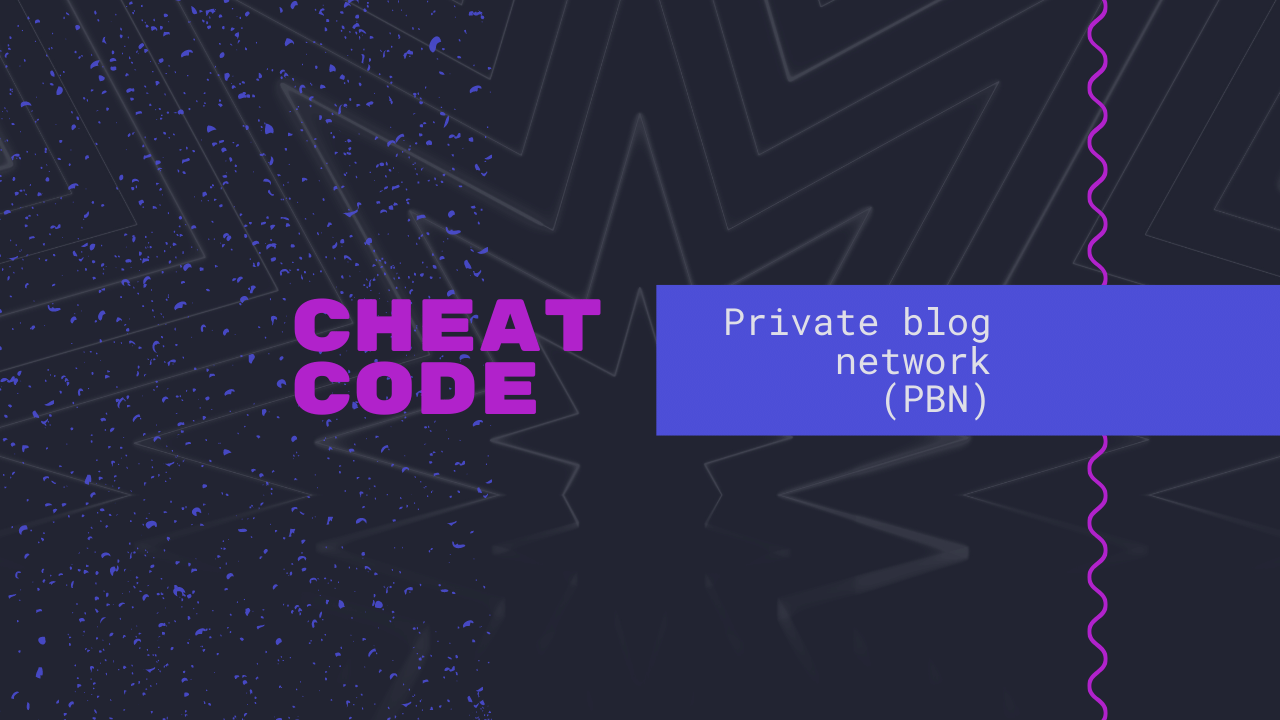A private blog network (PBN) is a group of websites or blogs that are created and managed for the sole purpose of increasing the search engine rankings of a primary website. The idea behind a PBN is to create a network of authoritative websites that link back to a single website, thereby boosting its ranking in the search engine results pages (SERPs).
A PBN typically consists of several domains, each with its unique IP address, hosting provider, and website design. The domains are often purchased and registered under fake names and addresses to conceal the true identity of the network owner. Each domain is then populated with high-quality, original content that is optimized for a specific set of keywords. The content is designed to be informative and engaging, with the primary goal of attracting backlinks from other websites.
Once the PBN is set up, the network owner will use it to create backlinks to the primary website. This is done by placing links within the content on the PBN websites that point to the primary website. The links are usually inserted in a subtle and natural way, so as not to arouse suspicion from search engines.
The idea behind a PBN is to create a network of websites that appear to be separate entities, but are actually controlled by the same owner. This allows the owner to have complete control over the backlinks that are created, and to ensure that the links are of high quality and relevant to the primary website.
While a PBN can be an effective way to improve the search engine ranking of a website, there are also risks involved. One of the main risks is the potential for search engines to discover the network and penalize the primary website for using artificial means to manipulate search engine rankings.
Search engines like Google are constantly updating their algorithms to detect and penalize websites that use black hat SEO tactics, and PBNs fall into this category. If a search engine detects a PBN, it may penalize the primary website by lowering its ranking or even de-indexing it altogether.
Another risk of using a PBN is the cost and time required to set it up and maintain it. Creating a PBN can be expensive, as it involves purchasing multiple domains and hosting accounts. In addition, maintaining a PBN requires ongoing effort and investment to ensure that the content is high-quality and relevant to the primary website.
Despite the risks involved, some website owners still choose to use PBNs to improve their search engine rankings. The main benefit of a PBN is that it provides complete control over the backlinks that are created, which can be very useful for websites in competitive niches.
In conclusion, a private blog network can be an effective way to improve the search engine ranking of a website, but it comes with potential risks and requires significant investment in terms of time and money. It is essential to weigh the benefits and risks carefully before deciding whether to use a PBN.
- Quality is key: When creating a PBN, it is important to focus on quality. The websites within the network should have high-quality, unique content that is relevant to the niche. Additionally, the websites should have natural-looking backlinks from other sources, as this will help to make the PBN appear more authentic.
- Diversity is important: When setting up a PBN, it is important to use a variety of different hosting providers and IP addresses to create diversity within the network. This will help to avoid detection by search engines, as it will make it more difficult for them to identify the connection between the websites within the network.
- Don’t rely solely on a PBN: While a PBN can be an effective way to improve search engine rankings, it is important not to rely solely on it. A diverse link building strategy that includes a variety of different tactics will help to create a more natural-looking link profile and avoid the risk of penalties from search engines.
- Keep the network small: While it may be tempting to create a large network of websites within the PBN, it is generally best to keep the network small. This will help to reduce the risk of detection by search engines, as smaller networks are less likely to raise suspicion.
- Be prepared for the risks: Using a PBN comes with a number of risks, including penalties from search engines and the possibility of losing all of the investment made in the network. It is important to be aware of these risks and have a plan in place in case something goes wrong.
- Keep the network hidden: It is essential to keep the existence of the PBN hidden from search engines, competitors, and anyone else who might be able to detect it. This means avoiding common footprints, such as using the same hosting provider or domain registrar for all of the websites within the network.
- Avoid using exact match anchors: Exact match anchors are anchor text that match the target keyword exactly. Using exact match anchors excessively within a PBN can raise red flags with search engines and increase the risk of penalties. Instead, use a variety of anchor text, including branded and generic anchors, to make the links appear more natural.
- Monitor the network regularly: It is important to monitor the PBN regularly to ensure that all of the websites are functioning properly and that the content is up-to-date and relevant. This will help to maintain the authority of the network and reduce the risk of penalties from search engines.
- Be prepared to take down the network: If the PBN is detected by search engines or the risk of detection becomes too great, it may be necessary to take down the network. This can be a difficult decision, as it may involve losing all of the investment made in the network, but it is important to weigh the risks carefully and be prepared to take action if necessary.
- Consider alternative strategies: While a PBN can be an effective way to improve search engine rankings, it is important to consider alternative strategies as well. Some alternatives include guest posting, broken link building, and social media marketing. A diverse link building strategy will help to create a more natural-looking link profile and reduce the risk of penalties from search engines.
- Keep the content fresh: It is important to keep the content on the websites within the PBN fresh and up-to-date. This will help to maintain the authority of the network and reduce the risk of penalties from search engines.
- Use social media to promote the websites: Social media can be a powerful tool for promoting the websites within the PBN and driving traffic to them. This can help to make the links appear more natural and reduce the risk of penalties from search engines.
- Use a variety of content formats: It is important to use a variety of different content formats within the PBN, including text, images, and videos. This will help to create a more natural-looking link profile and reduce the risk of penalties from search engines.
- Be patient: Building a successful PBN takes time and patience. It is important to take a long-term view and be prepared to invest the time and resources necessary to create a high-quality network.
- Stay up-to-date with search engine algorithms: Search engine algorithms are constantly evolving, and it is important to stay up-to-date with the latest changes. This will help to ensure that the PBN is not penalized and continues to improve search engine rankings.
- Hire a professional: Building and managing a PBN can be a complex and time-consuming process. Consider hiring a professional who has experience in creating and managing PBNs to ensure that the network is set up and maintained properly.
- Don’t over-optimize: Over-optimizing the websites within the PBN can raise red flags with search engines and increase the risk of penalties. It is important to avoid keyword stuffing, using exact match anchors excessively, and other tactics that may be viewed as spammy.
- Be selective with the websites within the PBN: It is important to be selective with the websites that are included within the PBN. Choose websites that are relevant to the target niche and have high domain authority. Avoid including low-quality websites or websites that are unrelated to the target niche.
- Consider geographic diversity: If the target audience is located in a specific geographic region, consider including websites within the PBN that are located in that region. This can help to create a more natural-looking link profile and reduce the risk of penalties from search engines.
- Use a variety of hosting providers: Using the same hosting provider for all of the websites within the PBN can raise red flags with search engines. Instead, use a variety of different hosting providers to make the network appear more natural.
- Don’t use expired domains with a shady history: Using expired domains can be a cost-effective way to build a PBN, but it is important to avoid domains with a shady history. This includes domains that have been penalized by search engines, used for spammy purposes, or associated with illegal activities.
- Consider the risk vs. reward: Building and maintaining a private blog network can be a high-risk, high-reward strategy. It is important to consider the potential risks, such as penalties from search engines, and weigh them against the potential rewards, such as improved search engine rankings.
- Keep track of backlink profiles: It’s important to monitor the backlink profiles of all the websites within the PBN. This will help you identify any spammy backlinks or potential issues that could harm your network’s reputation.
- Use multiple domain registrars: Using the same domain registrar for all the websites within the PBN could raise red flags with search engines. Instead, use multiple domain registrars to create a more natural-looking link profile.
- Vary anchor text: Using the same exact match anchor text for every link within the PBN could also be viewed as spammy by search engines. It’s important to vary your anchor text and use a mix of branded, naked URL, and long-tail keywords.
- Limit the number of outbound links: It’s important to keep the number of outbound links on each website within the PBN to a minimum. Too many outbound links could be seen as spammy and harm your network’s reputation.
- Use unique content: Avoid using duplicate or spun content on any website within the PBN. Search engines can easily detect this and penalize your network.
- Be careful with interlinking: While interlinking between websites within the PBN can be beneficial, it’s important to do so in moderation. Overuse of interlinking could raise red flags and harm your network’s reputation.
- Focus on niche relevancy: The websites within the PBN should be relevant to the niche you’re targeting. This will help improve the relevance and authority of the links and improve your network’s reputation.
- Consider the long-term: It’s important to take a long-term approach when building and maintaining a private blog network. This means regularly monitoring your network’s reputation, staying up-to-date with the latest search engine algorithms, and making necessary changes as needed.
In summary, building a successful private blog network requires careful planning and execution. It’s important to keep track of backlink profiles, use multiple domain registrars, vary anchor text, limit outbound links, use unique content, be careful with interlinking, focus on niche relevancy, and take a long-term approach. By following these guidelines, you can create a high-quality private blog network that improves your search engine rankings and boosts your online visibility.

